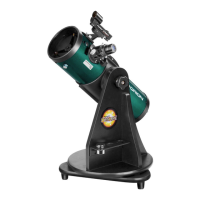16
17
How to Stargaze
How to Stargaze
With the right atmospheric conditions, you can see all of these objects with this telescope!
The collage on page 16 shows some of what
you can view in this telescope at different times
of the year. Deep sky objects, also referred to
as dim-fuzzies, are often hard to find. They are
worth the effort, being some of most wonderful
sights in the night sky. To find a deep sky object,
look at the monthly Evening Sky Map (www.
skymaps.com) to see what constellations are
visible this month. Use the National Audubon
Society Constellations Pocket Guide and locate
a visible constellation. They are listed alpha-
betically and have a detailed description of the
constellation and note if there are any deep sky
objects within. Many constellations have hidden
objects within them that are only visible with a
telescope or binoculars. Pay particular attention
to objects with a Messier Number, such as the
Orion Nebula (M-42) and the Andromeda Galaxy
(M-31). First published in 1774, Charles Messier
made this list to help observers identify objects
that might be mistaken for comets. The list of
110 Messier objects includes some of the
brightest and most attractive deep sky objects
observable from the northern hemisphere.
Star clusters are particularly pretty, usually
bright and easy to see. Note that some Messier
objects are very faint, and will take a while to
find and see. A few are very dim, but may seem
to appear like magic when you look at them out
of the corner of your eye. This is called “averted
vision” and works well when looking at very
dim objects in a telescope or binoculars.
You can also try a low-power (21mm) scan
of the Milky Way. Just cruise through the star
clouds of our galaxy. You’ll be amazed at the
rich fields of stars and objects you’ll see!

